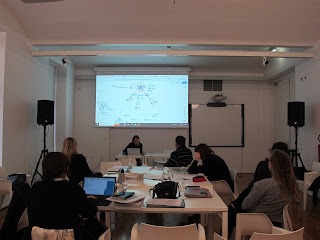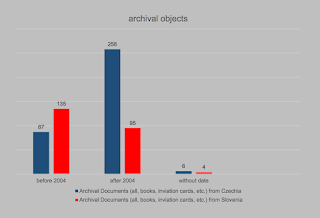Research Meeting at Moderna galerija, Ljubljana , 12-13 March 2024
Over the past year the project partners, Archive of Fine Arts in Prague, basis wien — Archiv und Dokumentationszentrum, and the Archive of Moderna galerija Ljubljana, have dedicated significant time to research. They have employed various methods to investigate the impact of the year 2004 on the art sector and how these effects can be identified, measured, and represented.
Alongside classical research methods and interviewing contemporary witnesses, they addressed queries directly to their own databases for finding and interpreting source material from the holdings of their archives,.
Each of these archives use relational databases not only for describing and indexing the objects within their collections but also for enriching them with supplementary data and linking them to persons, institutions, and events, such as exhibitions.
Over the course of several decades, each archive has amassed a wealth of structured data, presenting a rich resource for data analysis. The concept for the project was to develop a standardised set of database queries applicable across all three archives, thereby rendering the data comparable and conducive to drawing meaningful insights.
One aspect the participants investigated was artistic mobility, a term that is described as follows on the website of the European commission: “Mobility, whether for work, study, research, co-production, or participation in a residency or exchange programme, is an integral part of the regular practice and career of artists and cultural professionals. Mobility may not be simply a matter of personal choice, but also of professional survival.” (Source: https://culture.ec.europa.eu/culture-in-the-eu/mobility-of-artists-and-cultural-professionals)
Within the databases of the three archives various data could be used to describe artistic mobility:
- data on a person’s place of birth, place of residence and place of death
- data on where a person studied
- data on artistic residencies
- data on participation in exhibitions
It is worth noting that not all databases encompass all of these options, and not every person’s profile may contain all categories of data.
One line of enquiry was based on the characteristic shared by all three databases, which is the comprehensive documentation of exhibitions, including locations, dates, and the persons involved.
This documentation allowed for a comparative analysis of exhibition participation in relation to both an exhibition's location and the country associated with each person, through their birthplace, current residence or place of death.
The following diagrams based on data from the basis wien database can be taken as examples of how this can be applied.
By examining the results of queries delivering the number of exhibitions featuring persons connected to Czech Republic and Slovenia respectively, drawn from the basis wien database, it became evident that there was indeed a rise in participations from both countries before 2004 in comparison to after 2004.
The same is true for archival objects in the basis wien archive, which were published in Czech Republic and Slovenia respectively.
Both diagrams above show absolute numbers, meaning the actual number of exhibitions that meet the specifications of these queries. To create a reference, we also calculated the percentage of these exhibitions in relation to all exhibitions in Austria held before and after 2004.
This shows that while the percentage of exhibitions featuring persons with any geographical reference to Czech Republic in Austria increased from 25.37% before 2004 to 74.63% after 2004, and similarly, the percentage of exhibitions featuring persons with any geographical reference to Slovenia in Austria increased from 27.04% before 2004 to 72.96% after 2004, the total number of exhibitions in Austria only increased from 40.76% before to 59.24% after 2004
In order to exclude the possibility that the numbers are due only to a temporary peak of interest around the year 2004, a second set of queries examined the numbers of exhibitions year by year from 2004 to 2023, revealing a steady increase with a peak in 2014. The data also indicates a rapid decrease in 2020, attributed to travel restrictions during the Covid-19 pandemic, which remain noticeable in the years 2021 and 2022. As of the time of the queries, the year 2023 was not yet complete, resulting in fewer recorded results.
In addition to actual numbers and percentages, the partners also generated lists of results, for instance a list which contained the 132 solo exhibitions with persons who have a geographical relationship to Czech Republic in Austria. This allows for transparency while also providing valuable insights and a better understanding of the data results and their complexity.
The generated queries yielded extensive amounts of data which were thoroughly analysed and evaluated by each archive and discussed in the project group.
In summary, the queries and subsequent data analysis not only provided evidence supporting the thesis that the EU enlargement resulted in greater artistic mobility between the respective countries, but also yielded valuable insights into the partners' data repositories. Adopting a different perspective enabled a deeper understanding of the project's intricacies and revealed both commonalities and unique characteristics for each database.
During the final meeting in Ljubljana, the partners explored possibilities for integrating data from the different databases, with a view to future cooperation and data exchange. They also worked on ways to present and communicate the project results in a format accessible to audiences unfamiliar with the databases' details.
To accomplish the former, a set of test data was generated by identifying persons present in all three databases. This approach aimed to ensure the inclusion of the most comprehensive dataset possible. Subsequently, this list of 150 persons was enriched with additional data, such as date and place of birth, augmented with norm data (GND, VIAF, and Wikidata IDs). While this process was time-consuming due to its manual nature, importing the resultant list into a simple PostgreSQL database facilitated further analysis and querying.
The results can, in turn, be easily transformed into various diagrams, rendering the outcomes more comprehensible than mere numerical or percentage comparisons.
More extensive visualisations and presentations from all three partner archives will be shown in the context of an exhibition held at basis wien during the I REMEMBER THIS conference scheduled for October 7-8, 2024, in Vienna. This exhibition will serve as a platform for a deeper exploration of the project's findings, offering attendees the opportunity to engage directly with the data and its visual representations.
Disclaimer: „Funded by the European Union. Views and opinions expressed are however those of the author(s) only and do not necessarily reflect those of the European Union. Neither the European Union nor the granting authority can be held responsible for them.“










Comments
Post a Comment